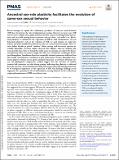Files in this item
Ancestral sex-role plasticity facilitates the evolution of same-sex sexual behavior
Item metadata
| dc.contributor.author | Mizumoto, Nobuaki | |
| dc.contributor.author | Bourguignon, Thomas | |
| dc.contributor.author | Bailey, Nathan W. | |
| dc.date.accessioned | 2022-11-10T18:30:01Z | |
| dc.date.available | 2022-11-10T18:30:01Z | |
| dc.date.issued | 2022-11-15 | |
| dc.identifier | 282096624 | |
| dc.identifier | fe036de3-658d-46d7-85b4-b99e1df06182 | |
| dc.identifier | 85141893789 | |
| dc.identifier.citation | Mizumoto , N , Bourguignon , T & Bailey , N W 2022 , ' Ancestral sex-role plasticity facilitates the evolution of same-sex sexual behavior ' , Proceedings of the National Academy of Sciences , vol. 119 , no. 46 , e2212401119 . https://doi.org/10.1073/pnas.2212401119 | en |
| dc.identifier.issn | 1091-6490 | |
| dc.identifier.other | RIS: urn:CF82FB02647A90DD581DA33776057CB3 | |
| dc.identifier.other | ORCID: /0000-0003-3531-7756/work/122720145 | |
| dc.identifier.uri | https://hdl.handle.net/10023/26368 | |
| dc.description | Funding: This study was supported by JSPS Research Fellowships for Young Scientists CPD Grant 20J00660 (to N.M.), Grant-in-Aid for Early-Career Scientists 21K15168 (to N.M.), and Okanawa Institute of Science and Technology core funding. N.W.B. gratefully acknowledges funding from the UK Natural Environment Research Council (NE/T000619/1). | en |
| dc.description.abstract | Recent attempts to explain the evolutionary prevalence of same-sex sexual behavior (SSB) have focused on the role of indiscriminate mating. However, in many cases, SSB may be more complex than simple mistaken identity, instead involving mutual interactions and successful pairing between partners who can detect each other’s sex. Behavioral plasticity is essential for the expression of SSB in such circumstances. To test behavioral plasticity’s role in the evolution of SSB, we used termites to study how females and males modify their behavior in same-sex versus heterosexual pairs. Male termites follow females in paired “tandems” before mating, and movement patterns are sexually dimorphic. Previous studies observed that adaptive same-sex tandems also occur in both sexes. Here we found that stable same-sex tandems are achieved by behavioral plasticity when one partner adopts the other sex’s movements, resulting in behavioral dimorphism. Simulations based on empirically obtained parameters indicated that this socially cued plasticity contributes to pair maintenance, because dimorphic movements improve reunion success upon accidental separation. A systematic literature survey and phylogenetic comparative analysis suggest that the ancestors of modern termites lack consistent sex roles during pairing, indicating that plasticity is inherited from the ancestor. Socioenvironmental induction of ancestral behavioral potential may be of widespread importance to the expression of SSB. Our findings challenge recent arguments for a prominent role of indiscriminate mating behavior in the evolutionary origin and maintenance of SSB across diverse taxa. | |
| dc.format.extent | 10 | |
| dc.format.extent | 1921334 | |
| dc.language.iso | eng | |
| dc.relation.ispartof | Proceedings of the National Academy of Sciences | en |
| dc.subject | Behavioral plasticity | en |
| dc.subject | Collective behavior | en |
| dc.subject | Leadership | en |
| dc.subject | Same-sex sexual behavior | en |
| dc.subject | Tandem runs | en |
| dc.subject | QH301 Biology | en |
| dc.subject | DAS | en |
| dc.subject | MCC | en |
| dc.subject.lcc | QH301 | en |
| dc.title | Ancestral sex-role plasticity facilitates the evolution of same-sex sexual behavior | en |
| dc.type | Journal article | en |
| dc.contributor.sponsor | NERC | en |
| dc.contributor.institution | University of St Andrews. School of Biology | en |
| dc.contributor.institution | University of St Andrews. Centre for Biological Diversity | en |
| dc.contributor.institution | University of St Andrews. Institute of Behavioural and Neural Sciences | en |
| dc.contributor.institution | University of St Andrews. St Andrews Bioinformatics Unit | en |
| dc.identifier.doi | 10.1073/pnas.2212401119 | |
| dc.description.status | Peer reviewed | en |
| dc.identifier.grantnumber | NE/T000619/1 | en |
This item appears in the following Collection(s)
Items in the St Andrews Research Repository are protected by copyright, with all rights reserved, unless otherwise indicated.

